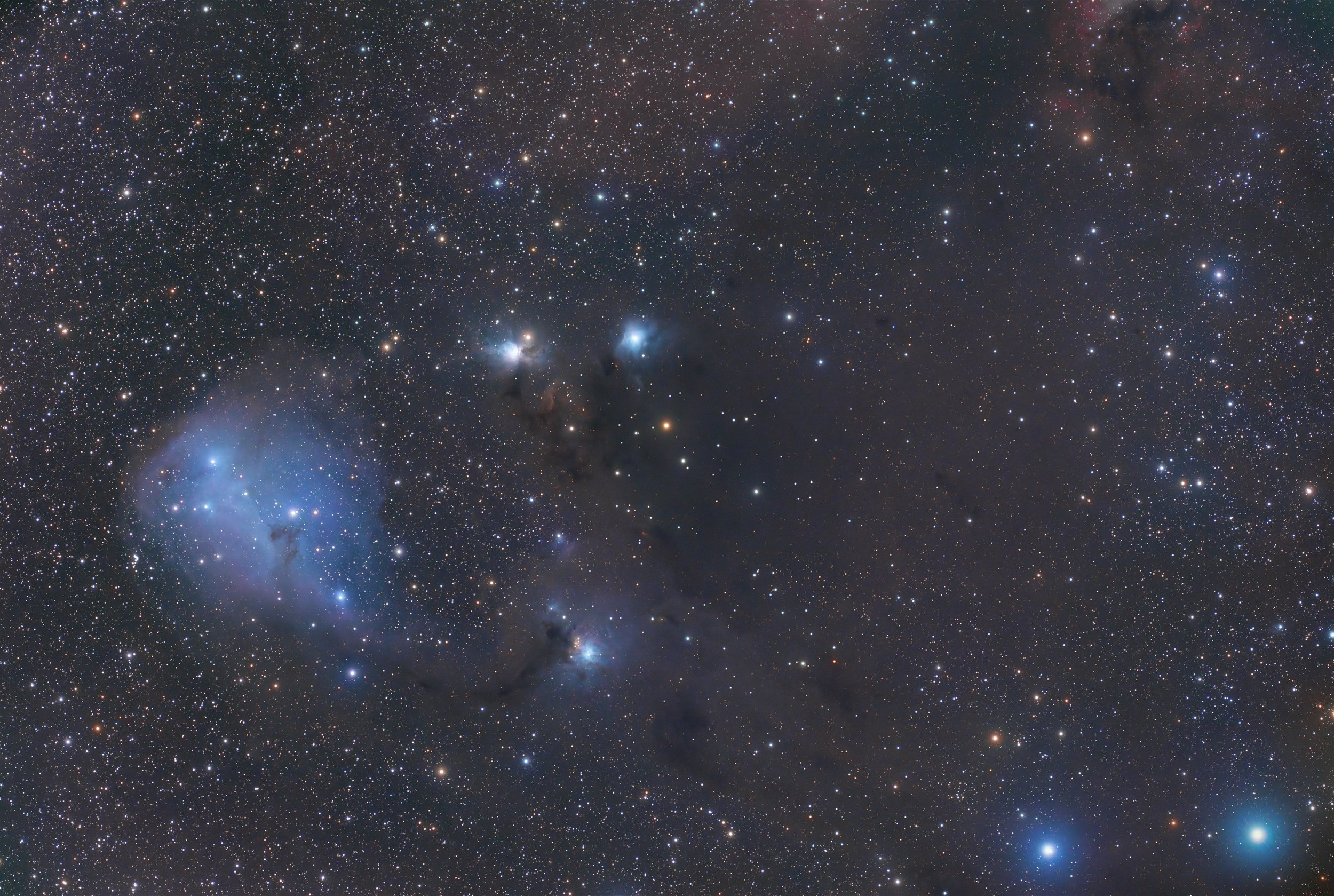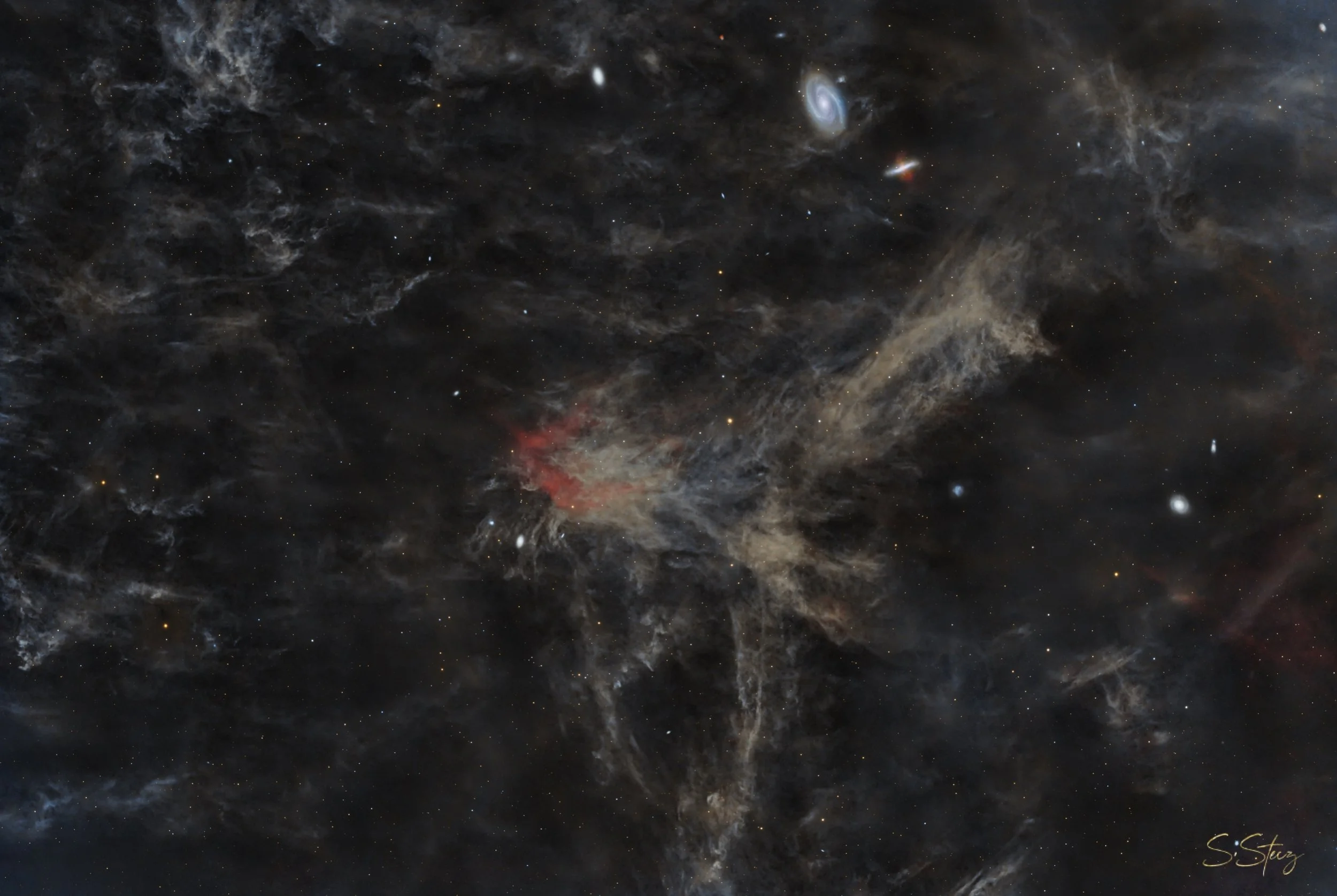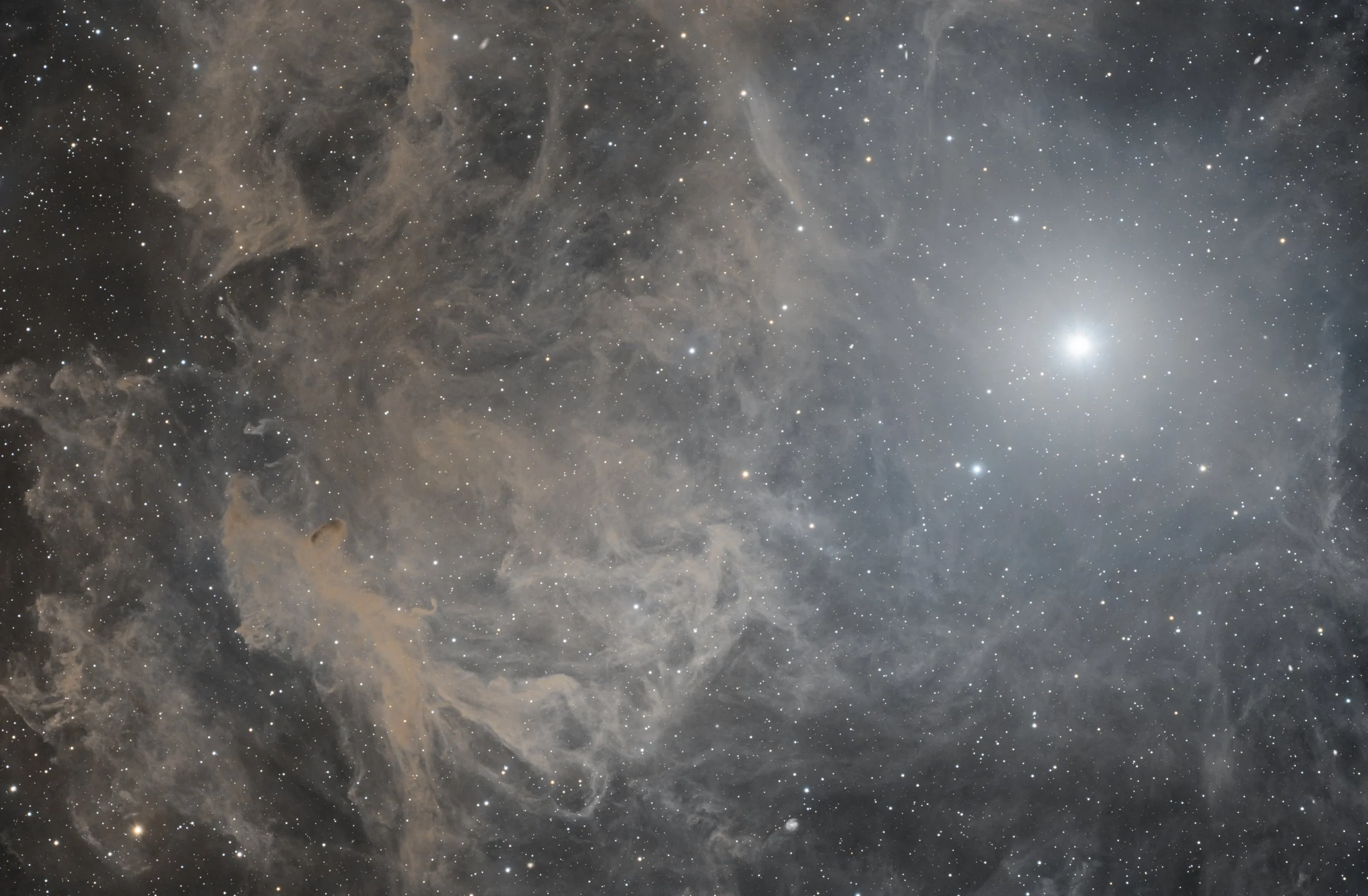
AAPOD2 Image Archives
MINERAL LUNAR MOSAIC
Seen from Earth, the Moon appears mostly grey—but a closer look with enhanced color processing reveals a mosaic of subtle mineral diversity across its surface. This striking mineral Moon portrait highlights variations in lunar soil composition using color: blue tones represent titanium-rich basaltic regions, while reddish and brownish areas indicate lower titanium content and ancient highlands. Mare Imbrium and Oceanus Procellarum stretch across the upper left in cool blues, while Tycho’s bright rays explode from the lower hemisphere in radiant whites, hinting at a relatively young impact site.
This detailed mosaic was captured using stacked and sharpened frames to bring out both color and clarity, with a natural orientation indicated by the compass rose in the corner. Despite the Moon being a familiar object, its geologic history remains one of contrasts—between dark volcanic plains and light, cratered highlands; between old and young; and, as revealed here, between one mineral and another. It’s a reminder that even our nearest celestial neighbor still holds mysteries visible only to those who look a little deeper.
NGC 4236 – Barred Spiral Galaxy in the M81 Group
NGC 4236 drifts quietly along the northern edge of the M81 Group, a barred spiral galaxy seen nearly side-on from our vantage point 11.7 million light-years away in the constellation Draco. This deep and richly detailed image, captured over 54.5 hours from Jestetten, Germany, reveals the galaxy's faint outer arms, peppered with pink-hued H II regions and blue clusters of young stars. The tilted bar and dusty spiral arms span over 100,000 light-years, rivaling the size of our own Milky Way.
Despite its size, NGC 4236 is unusually dim—a low surface brightness galaxy, with active star formation spread diffusely across its disk. Against a backdrop dense with distant galaxies and foreground stars, the extended exposure time allows the faintest filaments of gas and stellar birth clouds to emerge. These subtle structures are often lost in shorter exposures, making this view both scientifically valuable and visually mesmerizing.
NGC 2403 in LRGB-HOO
A vibrant cosmic portrait, this deep exposure showcases the face-on spiral galaxy NGC 2403 glowing amid the starry backdrop of Camelopardalis. Spanning nearly 100,000 light-years, the galaxy reveals an intricate structure of dusty spiral arms and radiant pink star-forming regions traced by hydrogen-alpha emission. Lying roughly 8 million light-years away, NGC 2403 is a member of the M81 Group and bears a striking resemblance to our own Milky Way’s satellite, the Triangulum Galaxy.
Captured from Hemel Hempstead, UK, with over 33 hours of total integration time, the image reveals fine galactic details—blue clusters of young stars, reddish emission nebulae, and the mottled glow of older stellar populations in the bulge. Bright foreground stars punctuate the frame with colorful diffraction spikes, while the galaxy’s faint outer arms softly blend into the darkness of intergalactic space.
Ghostly Light in Centaurus
Drifting through the southern skies in the constellation Centaurus, NGC 5367 is a hauntingly beautiful reflection nebula embedded in a dark molecular cloud complex. The wispy blue glow near the center is caused by starlight scattering off interstellar dust, primarily from a young binary star system still forming within the nebula’s opaque folds. This LRGB image reveals the full extent of the surrounding dust structures, illuminated not only by the central stars but also by the ambient starlight of the Milky Way, producing an ethereal interplay between light and shadow.
Captured with exquisite depth and detail, this image showcases the delicate filaments and ghostlike clouds that typify this under-observed region. NGC 5367 lies roughly 2,000 light-years away and is part of the larger cometary globule CG 12. Though visually faint, these kinds of nebulae are astrophysical laboratories—harboring nascent stars, turbulent gas dynamics, and cosmic dust grains that eventually seed planetary systems. The composition’s expansive framing and faint surrounding structures make it not just a target of scientific interest, but a portrait of interstellar stillness.
The Cosmic Horseshoe Gravitational Lens
Near the heart of the Leo constellation lies an extraordinary display of cosmic physics: the Cosmic Horseshoe. Captured over 50 hours by Justus Falk and Lenny Tomczak using amateur-grade telescopes, this deepfield image reveals the faint arc of a distant galaxy whose light has been distorted into a near-perfect ring. This phenomenon—gravitational lensing—is caused by the immense mass of a foreground galaxy warping spacetime and bending the path of light from a more distant background galaxy. Though barely perceptible in the image’s dense star field, the horseshoe-like structure is a profound testament to the invisible scaffolding of gravity shaping our universe.
The gravitational lens is located about 10 billion light-years away, behind a massive elliptical galaxy at a redshift of 0.44. The system, formally designated SDSS J1148+1930, is rarely imaged by non-professionals due to its extreme faintness. Yet this achievement from a ground-based setup in Germany exemplifies what patient observation, careful planning, and collaboration can achieve. The Cosmic Horseshoe not only offers a window into the early universe—it also shows that amateur astronomers can reach deep into space with extraordinary precision.
The Owl and its Outer Ring
Messier 97, also known as the Owl Nebula, is a planetary nebula located about 2,000 light-years away in the constellation Ursa Major. Its round appearance and twin dark cavities give it the look of a cosmic owl face, a structure shaped by strong stellar winds from the central white dwarf—what remains of a sun-like star near the end of its life.
Surrounding the brighter core is a faint, expansive halo of older gas, expelled in an earlier phase of stellar evolution and now slowly fading into the interstellar medium. This deep image captures both the intricate inner structure and the extended outer shell in fine detail. It was acquired from Dassendorf and Reinbek, Germany, where dark skies and stable conditions allowed for the faint outer ring to be revealed.
M81 & M82 in a Sea of Galactic Cirrus
This expansive wide-field view showcases the iconic galaxies M81 (top right) and M82 (below it) embedded in a rich tapestry of Integrated Flux Nebula (IFN) — faint, wispy clouds of dust within our own Milky Way, illuminated not by a single star, but by the collective glow of the galaxy itself.
M81, a grand-design spiral galaxy, lies about 12 million light-years away, while M82, its irregular, starburst companion, appears visibly disturbed — the result of a close gravitational encounter with M81. This interaction has triggered intense star formation and galactic winds, visible as red hydrogen filaments extending from M82’s core.
The remarkable depth of this image reveals not only the galaxies but the ghostly IFN structures that fill the space between stars, giving this field a dreamlike quality and a sense of three-dimensionality rarely seen in galactic imaging.
The Flaming Star and Tadpole Nebulae – A Fiery Embrace in Auriga
This vivid, high-resolution mosaic captures the emission nebulae IC 405 (left) and IC 410 (right) in a glowing hydrogen-oxygen blend, revealing sweeping tendrils of interstellar gas in the constellation Auriga. The Flaming Star Nebula (IC 405) surrounds the runaway star AE Aurigae, whose motion and radiation energize the swirling, flame-like hydrogen clouds. To the right, IC 410 hosts the young open cluster NGC 1893, whose hot, newborn stars shape the surrounding gas, including the iconic "Tadpoles" — dark, sinuous pillars of star-forming material.
Rendered in a refined HOO palette with subtle RGB enhancements, this image integrates 80 hours of exposure collected over two months. The long integration allows faint filamentary structures and faint OIII cores to emerge without overwhelming the natural depth. Wisps of hydrogen weave around both nebulae, linking them in a turbulent, star-forming environment that hints at the immense energy and complexity of stellar evolution.
The Lunar Highlands – Earth's Battered Companion
This image captures the most heavily cratered region on the visible side of the Moon: the lunar highlands. Unlike the smoother basalt plains of the lunar maria, the highlands are ancient, rugged terrain, dating back over 4 billion years. Their densely packed craters tell the violent story of the early solar system, when impacts were far more frequent and intense.
Craters of all sizes overlap across the highlands, with sharp rims and long shadows that highlight their depth and age. The sheer density of impacts in this region, visible in stark detail near the Moon’s limb, is a testament to its ancient and unshielded surface. The image’s angle enhances the topography, revealing ridges, ejecta blankets, and the chaotic texture of a surface shaped by billions of years of celestial bombardment.
NGC 5367 – Reflection Nebula in Centaurus
NGC 5367 is a stunning blue reflection nebula embedded in a dark cloud complex in the constellation Centaurus, around 2,000 light-years from Earth. Illuminated by young stars still forming within, the nebula’s dusty filaments scatter starlight in vivid hues of blue and purple. The intricate structure of glowing gas and dark obscuring lanes hints at the dynamic processes of star formation underway in this region of space.
In this deep image, the dusty environment is rendered in exquisite detail, with subtle pink and brown tones blending into the background of stars and distant galaxies. The glowing heart of the nebula contrasts sharply with the shadowy dust lanes that appear to ripple outward, giving the scene a three-dimensional feel. This reflection nebula is part of a larger molecular cloud complex, providing a beautiful yet fleeting window into the turbulent nursery of newborn stars.
Messier 13 – The Great Hercules Cluster
Messier 13, often called the Great Hercules Cluster, is one of the most prominent and best-known globular clusters in the northern sky. Located about 22,000 light-years from Earth in the constellation Hercules, this ancient stellar swarm contains several hundred thousand stars packed into a sphere roughly 145 light-years in diameter. At the cluster’s dense core, stars are separated by just a fraction of a light-year, creating a glittering core easily visible in amateur telescopes.
This image captures the cluster's brilliance and symmetry, as well as subtle color variations in its aging stellar population. With stars ranging from hot blue stragglers to cooler red giants, M13 offers a glimpse into the early history of our galaxy. Careful exposure and processing bring out both the dense center and the more diffuse outer halo of this remarkable galactic fossil.
LDN 1228 & LBN 552 – Dark Dust in Cepheus
Nestled within the vast Cepheus Molecular Cloud Complex, LDN 1228 and LBN 552 form a striking scene of interstellar dust and reflection nebulosity just 11 degrees from Polaris. These dense clouds of gas and dust are stellar nurseries, obscuring the background starlight while faintly reflecting the glow of nearby stars. Wisps of darker lanes wind across the frame, hinting at the dynamic structure and turbulence within the complex.
This two-panel mosaic was captured over four nights and comprises 17 hours of total exposure time. Each panel was imaged with 1.5 hours per channel for red, green, and blue, and 4 hours of luminance to reveal the fine structure in the dark nebulae. The careful composition and extended integration highlight the faint, dusty texture of this quiet yet complex region of the northern sky.
Sh2-290 (Abell 31) – A Fading Ghost in Cancer
Sh2-290, also cataloged as Abell 31, is one of the largest planetary nebulae in the night sky, spanning over 16 arcminutes across the constellation Cancer. Estimated to lie about 2,000 light-years from Earth, this ancient remnant of a dying star displays a delicate shell of ionized gas expanding into space, with a mix of red H-alpha emission and bluish OIII glow revealing its layered structure. The central white dwarf—faint and barely visible—illuminates the nebula's ghostly form, offering a glimpse into the Sun’s distant future.
Captured under the skies of Gandhinagar, Gujarat, this image highlights the challenge and reward of imaging such a faint target. Its low surface brightness demands long total exposure time and carefully balanced processing to reveal the subtle structures in the nebula’s extended halo. Despite its size, Abell 31’s soft appearance makes it an elusive gem in astrophotography, requiring both patience and technical precision to fully appreciate its spectral beauty.
Polaris and the Integrated Flux Nebula
This image captures Polaris, the North Star, surrounded by the faint, ghostly wisps of the Integrated Flux Nebula (IFN). Unlike typical emission or reflection nebulae, IFN is illuminated not by a single nearby star but by the collective glow of the entire Milky Way. The delicate tendrils of dust are incredibly faint and difficult to image, making this a challenging but rewarding target.
Using a remote observatory setup at Trevinca Skies, Spain, this deep exposure was acquired without guiding, demonstrating the precision of the equipment. The subtle structures of the IFN emerge around Polaris, blending into the rich star field and highlighting the hidden beauty of interstellar dust drifting quietly above our galactic plane.
NGC3532 - Wishing Well Cluster
NGC 3532, also known as the Wishing Well Cluster, is a dazzling open cluster located in the constellation Carina. Comprising several hundred stars, many of them brilliant blue and white, the cluster spans about one degree of sky—roughly twice the width of the full Moon—and lies approximately 1,300 light-years away. Its name comes from the visual impression that its bright stars resemble silver coins scattered at the bottom of a wishing well.
Photographed from the dark skies of Maceió, Alagoas, Brasil, this deep image showcases the cluster’s rich star field and subtle hues. As one of the most striking southern-sky open clusters, NGC 3532 offers both aesthetic appeal and scientific value, helping astronomers investigate the properties of young, metal-rich stellar populations within our galaxy.
Sh2-284 – Stellar Cradle in Monoceros
Sh2-284 is a striking emission nebula located in the constellation Monoceros, home to an open cluster of young stars that illuminate and sculpt the surrounding clouds of ionized gas. This region is an active stellar nursery, where radiation and winds from newly formed stars have carved out vast cavities and ridges in the interstellar medium, creating the dramatic structures seen in this image.
Captured over multiple nights from Paderborn, Germany, the image was created using a portable astrophotography setup and narrowband filters to isolate the distinct emission lines of hydrogen (Hα), sulfur (SII), and oxygen (OIII). With a total integration time of 21 hours and 15 minutes (85 exposures of 5 minutes per filter), the resulting composition reveals the nebula’s vibrant, textured beauty—an intricate tapestry of stellar birth.
Centaurus A (NGC 5128)
Centaurus A, also known as NGC 5128, is one of the most peculiar and studied galaxies in the southern sky. Lying about 13 million light-years away, this massive elliptical galaxy is strikingly bisected by a dark lane of dust—evidence of a galactic merger that fuels both its active nucleus and intense star formation.
This LRGB composition showcases the galaxy’s chaotic structure in vivid detail: the bright, rounded halo of old stars contrasts sharply with the dense, warped band of interstellar dust and gas slicing across its core. Radio observations reveal powerful jets emanating from a central supermassive black hole, a telltale sign of an active galactic nucleus.
Centaurus A offers a fascinating glimpse into the dynamic processes that shape galaxies over cosmic time—where destruction and creation occur hand in hand.
Dark Clouds in Chameleon - V
his hauntingly beautiful image captures the dark molecular clouds nestled within the southern constellation Chamaeleon, a region rich in cold gas and dust where stars are quietly forming. These dark nebulae, opaque to visible light, appear as ghostly silhouettes against the backdrop of the Milky Way, hiding young stars still cocooned in their natal clouds.
Imaged under the pristine skies of the Atacama Desert, the deep integration time allows subtle gradients of interstellar dust to emerge, painting a complex portrait of the region’s structure. The V designation refers to one of the several dense clumps within this expansive star-forming complex.
This image invites contemplation of stellar birth in one of the galaxy’s quietest corners, showing just how much beauty can lie in the shadows.
Thor’s Helmet – A Wolf-Rayet Bubble in Canis Major
Thor’s Helmet (NGC 2359) is a dramatic emission nebula located in the constellation Canis Major, roughly 12,000 light-years from Earth. Its helmet-like shape, complete with sweeping arcs and wing-like extensions, is sculpted by intense stellar winds from a rare, massive Wolf-Rayet star at its center. Though often mistaken for a planetary nebula, it is more akin to structures like the Crescent or Bubble Nebula—formed not by a dying sun-like star, but by a massive star in an extremely active stage of its life.
Spanning about 30 light-years across, this stellar bubble glows in vivid hues of ionized gas, most prominently in hydrogen, oxygen, and sulfur emission lines. Its intricate form and turbulent textures make it a favorite among astrophotographers and a vivid example of the power and beauty of massive stars reshaping their surroundings.
Abell 7 – A Ghost of Ancient Starlight
Abell 7 is a faint and rarely imaged planetary nebula located in the constellation Lepus, approximately 1,800 light-years from Earth. With a nearly spherical shell stretching about 8 light-years across, it represents the final exhalation of a dying star. Though the nebula itself is a youthful 20,000 years old, its central white dwarf is an ancient relic—estimated to be around 10 billion years in age—making this cosmic structure a quiet echo of stellar history.
Revealing the subtle structure and delicate textures of Abell 7 required nearly 70 hours of imaging time, captured through narrowband filters to isolate and enhance the emission from ionized gases. The result is a ghostly, intricate portrait of a star’s last breath, suspended in the darkness of space like a fading memory from the galaxy’s early days.





















